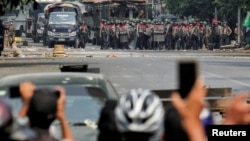Nearly 10 months into Myanmar’s military coup, the country’s media is striving to keep reporting while navigating arrests and harassment from the junta.
Thousands of protesters have refused to accept military rule, including ousted politicians, activists, religious leaders, and others, and fighting has broken out between junta and local defense forces.
But local media trying to cover that opposition come up against obstacles.
Early on, the junta revoked the licences of five media outlets. It was a decision that “shook” the industry, said Thomas Kean, editor-in-chief at the English-language news outlet Frontier Myanmar.
“Since then, more have been banned, more journalists have been arrested and it’s been downhill since then, gradually more difficult, month by month,” said Kean.
One of his own team—American journalist Danny Fenster—was jailed for nearly six months.
Byond revoking licenses and arrests, the military cut access to internet and amended a telecommunications law to allow for prison sentences.
The junta has said it is acting to bring stability. Military spokesperson Zaw Min Tun has previously said that the military “respects press freedom” and arrests only journalists who incite unrest.
History of repression
Rights groups including Reporters Without Borders (RSF) say the coup has put media freedom back a decade. But some say the country never enjoyed real press freedom, even under Aung San Suu Kyi’s National League for Democracy government.
Under the last period of military rule, the country was deemed one of the most censored places globally. Access to independent news websites was blocked, visas to foreign media were seldom granted and the few privately owned media operations had to submit content for review before publication.
Those restrictions started to ease in 2011, when Thein Sein was elected as the first civilian Prime Minister in nearly half a century.
His early policies relaxed restrictions and abolished the pre-publication censorship regulation.
Around that time Kean was working for Myanmar Times, one of the country’s oldest privately owned English-language newspapers.
“From around mid-2010 you could get the sense that, it was still heavily censored, but you could feel the censorship was getting lighter. For the standards of the time, a fair bit of [political] debate was getting into newspapers,” Kean told VOA from Melbourne, Australia.
The relaxing of media rules had an immediate impact. Myanmar showed a slow but steady improvement on RSF’s annual press freedom index, moving from 151 in 2013—its first appearance—to a record high of 131 in 2017. The index scores countries on media rights, with 1 being the most free. Myanmar in early 2021 ranked 140.
As the censorship laws were scrapped, Myanmar saw a wave of privately owned media outlets forming. “2015 was peak of print advertising market,” Kean said.
The following year, major telecom companies began operating in Myanmar.
However, in a trend seen globally, the expansion of internet services had a negative impact on the print industry, which saw a decline in ad revenue.
Aye Chan Naing, co-founder of the independent media outlet Democratic Voice of Burma (DVB), told VOA those issues persist today.
“The business, and streaming, it's also become threatening for independent journalism—like, the online Google, Facebook, all the advertising income, it's going into the digital marketing, and media are not really surviving,” he said.
While censorship was eased during this period, reporters still risked arrest and restrictions.
In 2017, Reuters journalists Wa Lone and Kyaw Soe Oo were jailed for more than 500 days over their reporting on the Myanmar military’s massacre of members of the Rohingya in Rakhine state.
But the ramping up of arrests since the coup has led outlets like Frontier Myanmar and DVB to change how—and where—they report.
Media in exile
One of the biggest changes said Naing, who operates DVB from exile, is that reporters have to rely heavily on numerous sources.
“The [biggest] challenge is we have to depend on our sources, second hand or third hand. It's very hard for us to be on the ground. And we have to depend on witnesses,” he said.
At least three DVB journalists were detained in Myanmar for several months, until being released as part of a mass amnesty in October.
A further three fled to Thailand but were arrested and given suspended prison sentences for illegal entry. They have since relocated to a third country.
The obstacles and difficulty in reporting has made social media and citizen journalists vital, said Kean.
“To some extent media organizations can operate remotely, but we can’t send reporters around the country like we used to. It’s very difficult to verify exactly what’s happening,” he said.
The Yangon-based Frontier Myanmar launched in 2015, publishing feature-style journalism targeting English speakers.
But shortly after February’s coup, it was forced to cease the print edition.
“We were worried about the safety of our distribution staff and we shifted focus to breaking news,” Kean said. “We didn’t want to get distracted by trying to write features for a magazine, because that wasn’t the kind of information people needed at the time.”
After an outbreak of COVID-19 among the paper’s team, and a disappearing print audience, Kean said it didn’t make sense to resume publishing for the moment.
In an email to subscribers last month, Frontier Myanmar reassured readers that the publication had only temporarily suspended its services.
“It’s obviously not something we wanted to do, but we think it’s in the best interests of the Frontier team and necessary for our long-term survival,” the email read.
The detention of the paper’s managing editor, Fenster, also had an impact.
Fenster, 37, was freed last week after nearly six months in prison on accusations that he was still working for Myanmar Now, an outlet banned by the junta earlier this year. The journalist had resigned from that company months before the coup.
Kean said Frontier Myanmar were “incredibly relieved” that Fenster was finally released.
“We were in the dark as to what was going on, in terms of the efforts to have Danny released. Until he got on the plane and left Myanmar airspace, we were still not celebrating,” Kean said.
However, at least 37 journalists remain in detention in Myanmar, according to Reporting ASEAN, an organization documenting the crackdown.













